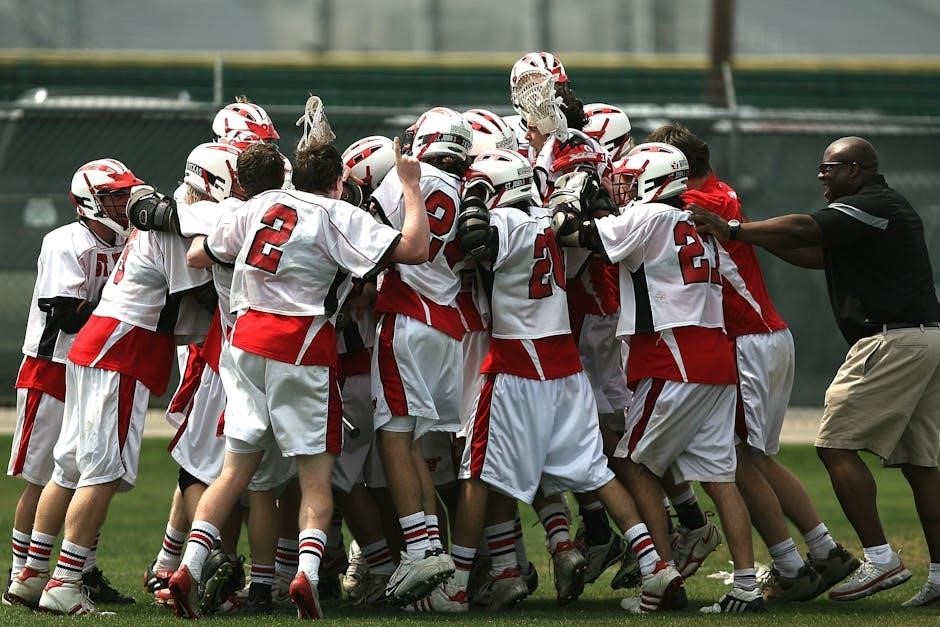The concept of 5 dysfunctions of a team is discussed in a book by Patrick Lencioni, available as a pdf, with exercises to help teams overcome their weaknesses and improve performance effectively always.
Overview of the Five Dysfunctions
The five dysfunctions of a team are well-documented in various resources, including a pdf book by Patrick Lencioni, which provides a comprehensive overview of the common pitfalls that teams face.
The five dysfunctions include absence of trust, fear of conflict, lack of commitment, avoidance of accountability, and inattention to results, all of which can hinder a team’s ability to work effectively together.
These dysfunctions can have a significant impact on a team’s performance and overall success, and understanding them is crucial to overcoming them and building a high-performing team.
The resources available, including exercises and assessments, can help teams to identify and address these dysfunctions, and to develop strategies for improving their collaboration and productivity.
By understanding the five dysfunctions and taking steps to overcome them, teams can improve their communication, build trust, and achieve their goals more effectively.
This overview provides a foundation for understanding the five dysfunctions and how they can be addressed, and is an important step in building a high-performing team.
The information is widely available in pdf format and can be easily accessed and shared with team members.
The five dysfunctions are a fundamental concept in team development and are essential for teams to understand and address in order to achieve success.

Understanding the Five Dysfunctions
Teams must recognize and analyze their own dysfunctions to improve performance and achieve goals effectively always using resources.
Absence of Trust
The absence of trust is a fundamental dysfunction that can hinder a team’s ability to work effectively together. According to Patrick Lencioni, trust is the foundation of a healthy team, and without it, teams can become mired in politics and bureaucracy. When team members do not trust each other, they are less likely to be open and honest, and more likely to engage in behaviors that undermine the team’s goals. To overcome the absence of trust, teams must work to build a culture of vulnerability and openness, where team members feel comfortable sharing their thoughts and feelings. This can be achieved through exercises and activities that promote teamwork and collaboration, such as team-building workshops and trust-building games. By building trust, teams can create a foundation for success and improve their overall performance. Teams must recognize the importance of trust and work to establish it in order to achieve their goals.
Fear of Conflict
The fear of conflict is a dysfunction that can prevent teams from having open and honest discussions, leading to poor decision-making and a lack of buy-in from team members. When teams fear conflict, they may avoid discussing important issues or may not share their true opinions, leading to a lack of clarity and direction. To overcome the fear of conflict, teams must learn to embrace constructive conflict and view it as an opportunity for growth and improvement. This can be achieved through exercises and activities that promote healthy conflict, such as debate and discussion sessions. By learning to navigate conflict in a productive way, teams can make better decisions and achieve their goals more effectively. Teams must recognize that conflict is a natural part of the team development process and work to create a culture where constructive conflict is encouraged and valued, leading to better outcomes and improved team performance.

Addressing the Dysfunctions
Teams can address dysfunctions through exercises and activities, improving communication and trust, and enhancing overall team performance effectively always with proper guidance and support systems in place online.
Conquering Team Dysfunction
Conquering team dysfunction requires a thorough understanding of the five dysfunctions and a willingness to address them. According to Patrick Lencioni, teams can overcome their dysfunctions by creating a culture of trust, encouraging open communication, and fostering a sense of accountability. This can be achieved through various exercises and activities, such as team-building workshops and trust-building games. By working together to overcome their dysfunctions, teams can improve their overall performance and achieve their goals more effectively. The exercises and activities outlined in the 5 dysfunctions of a team pdf can help teams to identify and address their specific dysfunctions, and to develop strategies for overcoming them. With persistence and dedication, teams can conquer their dysfunctions and become more cohesive, productive, and successful. By following the principles outlined in the book, teams can create a positive and supportive team culture that encourages collaboration, creativity, and growth.
Overcoming Dysfunction 5: Focusing on Results
Overcoming the fifth dysfunction, inattention to results, requires teams to shift their focus from individual goals to collective success. This can be achieved by setting clear, measurable goals and establishing a system of accountability. The 5 dysfunctions of a team exercises pdf provides guidance on how to create a results-oriented team culture. By prioritizing collective results, teams can overcome the tendency to focus on individual achievements and instead work together to achieve common objectives. This requires a fundamental shift in mindset, from a focus on personal success to a focus on team success. The exercises and activities outlined in the pdf can help teams to develop this mindset and to create a culture that values collective achievement. By focusing on results, teams can achieve greater success and make a more significant impact. The 5 dysfunctions of a team model provides a framework for overcoming this dysfunction and achieving greater team effectiveness.

Implementing Team-Building Strategies
Team-building strategies are implemented using various tools and exercises to foster collaboration and productivity effectively always online.
Team-Building Road Map
A team-building road map is a guide to help teams overcome the 5 dysfunctions, providing a clear plan and timeline for implementation.
The road map outlines the steps necessary to build trust, foster open communication, and encourage collaboration among team members.
It also includes exercises and activities to help teams stay focused on their goals and avoid distractions.
By following the team-building road map, teams can create a positive and productive work environment, leading to increased success and job satisfaction.
The road map is a flexible tool that can be tailored to meet the specific needs of each team, and it can be used in conjunction with other team-building strategies and exercises.
Teams can use the road map to identify areas for improvement and develop a plan to address these issues, ultimately leading to a more cohesive and effective team.
The team-building road map is an essential tool for any team looking to improve their performance and achieve their goals.
Tools and Exercises
Various tools and exercises are available to help teams overcome the 5 dysfunctions, including assessment forms and workbooks.
These tools provide a framework for teams to identify and address their weaknesses, and to develop strategies for improvement.
Exercises such as trust-building activities and conflict resolution techniques can help teams to communicate more effectively and work together more efficiently.
Teams can also use online resources, such as pdf documents and videos, to access a wide range of tools and exercises.
These resources can be tailored to meet the specific needs of each team, and can be used in conjunction with other team-building strategies.
By using these tools and exercises, teams can develop the skills and knowledge they need to overcome the 5 dysfunctions and achieve their goals.
The tools and exercises are designed to be flexible and adaptable, allowing teams to use them in a way that suits their needs and preferences.

Regular use of these tools and exercises can help teams to stay focused and motivated.
